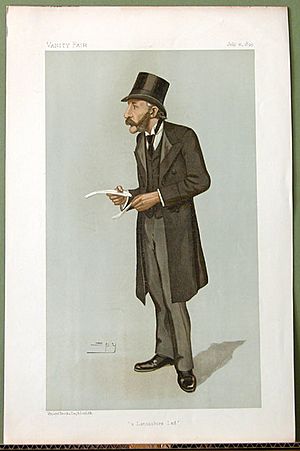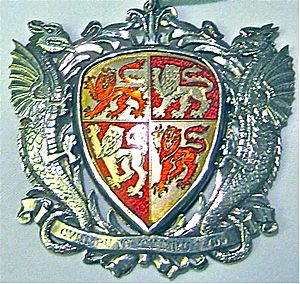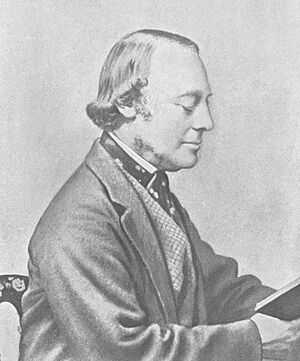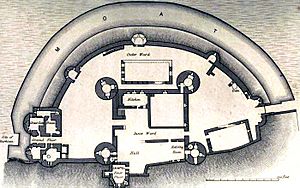Cambrian Archaeological Association facts for kids
The Cambrian Archaeological Association (which is Cymdeithas Hynafiaethau Cymru in Welsh) is a group that started in 1846. Its main goal is to study, protect, and share information about the old buildings, history, language, and traditions of Wales and the areas near its borders, known as the Welsh Marches. They also want to teach people about these important topics.
The association does many things. They organize talks, field trips to historical sites, and study tours. They also publish a special magazine called Archaeologia Cambrensis and other books. Plus, they give money (grants) to help people do research and publish their findings.
Contents
What the Association Does
Meetings and Learning Events
The association holds two main meetings every year. One is a week-long summer trip, and the other is a shorter autumn weekend. During these meetings, members visit old sites and monuments all over Wales. Sometimes, they even travel to England, Scotland, Ireland, or other countries.
They also have special conferences every two years around Easter. These conferences feature talks about new discoveries and important topics in history and archaeology. Each year, they arrange a lecture in the Welsh language at the National Eisteddfod, which is a big Welsh festival.
Helping Research and Education
The association gives out research grants every year, usually between £500 and £2000. These grants help archaeologists and historians with their projects. For example, in 2012, a grant helped with work on a Roman villa found in Ceredigion.
They also have awards for schools. The Blodwen Jerman Schools Prize is given each year to a Welsh school that does a great job promoting archaeology and history. The G. T. Clark Prizes are awarded every five years for the best published work on the archaeology and history of Wales and the Marches. These prizes cover different time periods, from ancient times to more recent history.
Books and Magazines
Besides their main magazine, Archaeologia Cambrensis, the association has a long history of publishing other books about Welsh history and archaeology. One big project was publishing a copy of Thomas Dineley's book about a journey through Wales in 1684.
More recently, between 1978 and 1998, they worked with Cadw (the Welsh government's historic environment service) to publish important books about archaeological digs in Wales. In 2013, they published a special book called Reflections on the Past. This book celebrated the work of Frances Lynch, a prehistorian who contributed a lot to the association.
Other important books they have published include:
- Sir Stephen Glynne's Notes on the Older Churches in the Four Welsh Dioceses (1903). These notes describe many Welsh churches before they were changed by Victorian builders.
- Rev John Skinner's Ten Days' Tour through the Isle of Anglesea December 1802 (1908). Skinner was a parson who traveled widely, recording old monuments.
- Edward Lhuyd's Parochialia (1909–1911).
- Richard Fenton's Tours in Wales (1804–1813) (1917). These diaries describe Fenton's travels in Wales.
History of the Association
How it Began (1846–1855)
The Cambrian Archaeological Association was started when people in Wales felt a stronger sense of their own national identity. At this time, older societies in London that focused on Welsh culture were becoming less active.
The British Archaeological Association was formed in 1844, and soon after, another group called the Royal Archaeological Institute broke away. These groups started a new way of doing things: holding yearly meetings in different places and publishing a journal. The Cambrian Archaeological Association decided to follow this successful model for Wales and the Marches.
The main person behind starting the Cambrian Archaeological Association was the Rev. Harry Longueville Jones. He wrote a paper called 'On the study and preservation of national antiquities', asking interested people to join and form a group. Longueville Jones was also a talented artist, and his drawings were used in the early issues of Archaeologia Cambrensis.
First Few Years (1847–1855)
The first annual meeting of the association was held in Aberystwyth in September 1847. The first president was Sir Stephen Richard Glynne. By the second meeting, the group had grown to 350 members.
In 1849, Harry Longueville Jones left his role as a secretary because he got a job inspecting schools in Wales. However, he remained very active and later became the editor of Archaeologia Cambrensis again in 1855.
Many smart people were involved in the association during these early years. One was G. T. Clark, who became an expert on British Castles. His first article in Archaeologia Cambrensis was about Kidwelly Castle.
Another important person was Edward Augustus Freeman, who later became a famous historian. He wrote articles about church architecture in Wales. John Obadiah Westwood, an expert on insects, also studied ancient carved stones in Wales. The association even helped publish his big book on these stones.
In the 1850s, some disagreements happened among the members. John Williams, one of the early leaders, had different ideas about Welsh history. Because of these disagreements and money problems, Williams and another secretary resigned. Membership dropped, but the association worked to fix things. Williams went on to create a different society, but it eventually disappeared.
Getting Back on Track (1856–1880s)
After the difficulties, the association worked hard to rebuild itself. They updated their goals and adopted a new set of rules in 1856. During this time, Cardale Babington led the main committee, and Rev E L Barnwell was the general secretary.
The association became more focused on archaeology. They helped fund excavations at the Roman fort of Caersws, and the findings were published in Archaeologia Cambrensis. Longueville Jones, as editor, wrote many articles about archaeological sites. He pushed for a system to record and protect ancient monuments, which helped lead to the creation of the Welsh Royal Commission in 1908.
E L Barnwell also wrote many articles on various topics, including archaeology and old buildings. Other important publications included work by Hon W O Stanley on ancient burial mounds and by Edward Blore on Wigmore Abbey. Blore was a famous architect who helped rebuild Buckingham Palace.
The association also started working with the "Office of Woods and Forests," which looked after royal castles in Wales. The Cambrians helped with the restoration of Caernarvon Castle. They also arranged to lease castles and other monuments, like the monastery of Strata Florida, to protect and display them to the public.
Later Victorian Period to World War I
By the 1880s, many of the original members were no longer active. New important figures joined, like John Rhys, a professor of Celtic studies at Oxford. The focus of the association started to include more Celtic studies.
A very important person during this time was John Romilly Allen. He joined the association in 1875 and became the editor of its journal in 1889, staying in that role until his death in 1907. Romilly Allen became the leading expert on ancient carved stones from the post-Roman period. He strongly believed that Wales should have its own national museum. He was upset when ancient Welsh items were bought by museums outside Wales. It was fitting that the National Museum of Wales was officially started in 1907, the year Romilly Allen passed away.
Romilly Allen also didn't like it when other groups tried to interfere in Welsh matters. For example, when the Cambrians were excavating Strata Florida Abbey, another society criticized their work. Romilly Allen, as editor, made it clear that while the Cambrian Archaeological Association was open to polite advice, they would not let other societies dictate how their explorations should be done.
The association also became more adventurous with its summer meetings. They started visiting other "Celtic" lands outside Wales, like Cornwall in 1862 and the Isle of Man in 1865. More exciting trips included Brittany in 1889 and Ireland in 1891. In 1899, they even hired a ship to sail around the Western Isles of Scotland to see remote ancient sites.
After Romilly Allen's death in 1907, the Rev Rupert Morris took over as editor. He continued to edit Archaeologia Cambrensis until his death in 1917. When World War I started, the association managed to keep publishing, though they reduced the journal to two issues a year. The summer meetings were stopped, and a general meeting was held each year in Shrewsbury. William Boyd Dawkins, a famous geologist, helped organize the association during these years and was knighted in 1917.
From 1918 to 1950
By the mid-1920s, the newly established National Museum of Wales began to influence the association. Mortimer Wheeler became the museum's director in 1924. He started important excavations at Roman sites like Segontium and Brecon Gaer. The reports on these digs were published in another journal, not Archaeologia Cambrensis, because the Cambrians' journal format wasn't suitable for large excavation reports. As a result, Archaeologia Cambrensis changed to a larger size in 1928 to better accommodate such reports.
Mortimer Wheeler also encouraged non-professional archaeologists in their research. For example, Harold Hughes and Dr Willoughby Gardner studied Hillforts in North Wales. Their work formed the basis for later excavations. Sir Cyril Fox, who followed Wheeler as museum director, published his survey of Offa's Dyke in parts in Archaeologia Cambrensis.
During World War II (1939-1945), the Cambrians couldn't hold meetings, but they continued to publish Archaeologia Cambrensis. In 1946, to celebrate the association's 100th birthday, that year's volume was called 100 Years of Welsh Archaeology 1846–1956. This book gave a great overview of what was known about Welsh archaeology at the time. In the 1940s, Frederick Herbert Crossley, a historian of church architecture, began a detailed survey of old wooden carvings in Welsh churches.
Leaders of the Association (Presidents)
In the early days, the president of the Cambrian Archaeological Association was usually a wealthy landowner or a high-ranking church official from Wales. The first president was Sir Stephen Glynne, 9th Baronet, who was very passionate about churches. The president's role was, and still is, to help arrange visits and the summer meetings. Usually, a president serves for one year, but sometimes for longer.
Many early presidents were church leaders or Members of Parliament. These summer meetings were often used for discussions beyond just archaeology. For example, some presidents were involved in railway companies that were expanding in Wales at the time. However, this doesn't mean they weren't interested in archaeology. Many were keen Antiquaries (people who study old things), like Octavius Morgan and Stanley Leighton.
A change started around 1881, when Professor Cardale Babington, a botanist and archaeologist from Cambridge University, became president. He was followed by other academics like Professor John Rhys of Oxford, an expert in Celtic studies. Later, Professor Sir William Boyd Dawkins, an archaeologist and geologist, served as president for six years, guiding the association through World War I.
After World War I, more changes happened. Leading archaeologists like (Sir) Mortimer Wheeler (1930) and (Sir) Cyril Fox (1933) became presidents. Architects, historians, and Celtic scholars also took on the role. Since World War II, the presidents have been a mix of top academics, professional architects, archaeologists, and local historians. In 1988, Frances Lynch became the first female president, and since then, five more women have held the position.
Annual Meetings and Presidents List
- 1847 Aberystwyth: Sir Stephen Glynne
- 1848 Caernarvon: Sir Stephen Glynne
- 1849 Cardiff: Edwin Wyndham-Quin, 3rd Earl of Dunraven and Mount-Earl Viscount Adare
- 1850 Dolgellau: William Watkin Edward Wynne
- 1851 Tenby: John Campbell, 2nd Earl Cawdor
- 1852 Ludlow: Hon Robert Henry Clive MP
- 1853 Brecon: Sir Joseph Bailey, 1st Baronet MP
- 1854 Ruthin: Frederick Richard West MP
- 1855 Llandeilo Fawr: George Rice-Trevor, 4th Baron Dynevor
- 1856 Welshpool: Edward James Herbert, 3rd Earl of Powis
- 1857 Monmouth: Octavius Morgan
- 1858 Rhyl: Bishop Thomas Vowler Short of St Asaph
- 1859 Cardigan: Bishop Connop Thirwall of St David's
- 1860 Bangor: Charles Griffith Wynne later Charles Wynne-Finch
- 1861 Swansea: Henry Hussey Vivian
- 1862 Truro: Henry Hussey Vivian
- 1863 Kington: Sir John Benn Walsh Bt MP
- 1864 Haverfordwest: John Henry Scourfield
- 1865 Douglas, Isle of Man: Henry Bougham Loch
- 1866 Machynlleth: George H. R. C. W. Vane-Tempest, or The Earl Vane
- 1867 Hereford: F B Twisleton-Wykeham-Fiennes, 16th Baron Saye and Sele
- 1868 Portmadoc: E. F. Coulson
- 1869 Bridgend: Edwin Richard Wyndham-Quin, 3rd Earl of Dunraven
- 1870 Holyhead: John Wynne Jones, Archdeacon of Bangor
- 1871 Hereford: John Wynne Jones, Archdeacon of Bangor
- 1872 Brecon: Sir Joseph Bailey, 2nd Baronet MP
- 1873 Knighton: Arthur Walsh
- 1874 Wrexham: Sir Watkin Williams -Wynn 6th Baronet
- 1875 Carmarthen: Bishop William Basil Jones of St David's
- 1876 Abergavenny: Professor Edward Augustus Freeman
- 1877 Caernarvon: Admiral Lord Clarence Paget
- 1878 Lampeter: Bishop William Basil Jones of St David's
- 1879 Welshpool: Charles Watkin Williams-Wynn
- 1880 Pembroke: C. E. G. Philipps
- 1881 Church Stretton: Professor Cardale Babington
- 1882 Llanrwst: H. R. Sandbach
- 1883 Fishguard: C. E. G. Philipps
- 1884 Bala: Sir Watkin Williams-Wynn 6th Baronet
- 1885 Newport: Lord Tredegar
- 1886 Swansea: John Talbot Dillwyn Llewellyn
- 1887 Denbigh: Charles Salusbury Mainwaring
- 1888 Cowbridge: Richard Lewis, Bishop of Llandaff
- 1889 Brittany & London: Dr le Closmadeuc
- 1890 Holywell: Llewelyn N. V. Lloyd-Mostyn, 3rd Baron Mostyn
- 1891 Kerry, Ireland: Prof John Rhys
- 1892 Llandeilo Fawr: Sir James William Drummond
- 1893 Oswestry: Stanley Leighton MP, FSA
- 1894 Caernarvon: George Douglas-Pennant, 2nd Baron Penrhyn
- 1895 Launceston, Cornwall: Hardinge Giffard, 1st Earl of Halsbury
- 1896 Aberystwyth: Hardinge Giffard, 1st Earl of Halsbury
- 1897 Haverfordwest: F. Lloyd Philipps
- 1898 Ludlow: Sir Owen H. P. Scourfield
- 1899 West Coast of Scotland and London: Lord Windsor
- 1900 Merthyr Tydfil: Lord Aberdare
- 1901 Newtown: Lieut-Col E Pryce Jones
- 1902 Brecon: Joseph Bailey, 2nd Baron Glanusk
- 1903 Portmadoc: Richard Henry Wood
- 1904 Cardigan: John William Willis-Bund
- 1905 Shrewsbury: D. H. Thomas, Archdeacon of Montgomery
- 1906 Carmarthen: Sir John Williams 1st Baronet
- 1907 Llangefni: Sir Richard H. Williams Bulkely
- 1908 Monmouth: Rev Prof A. H. Sayce

- 1909 Chester: Sir Henry Hoyle Howarth
- 1910 Llandrindod Wells: Charles Dillwyn-Venables-Llewellyn
- 1911 Abergele: Professor William Boyd Dawkins
- 1912 Cardiff: Robert Windsor-Clive, 1st Earl of Plymouth
- 1913 Devizes: Professor William Boyd Dawkins
- 1914 Shrewsbury: Professor William Boyd Dawkins
- 1915 Shrewsbury: Professor William Boyd Dawkins
- 1916 Shrewsbury:Professor William Boyd Dawkins
- 1917 Shrewsbury: Professor William Boyd Dawkins
- 1918 Shrewsbury: Professor William Boyd Dawkins
- 1919 Dolgellau: Sir E. Vincent Evans
- 1920 Swansea: Lt Col W. Ll. Morgan
- 1921 Ruthin: Sir E Vincent Evans
- 1922 Haverfordwest: Sir Evan D. Jones Bt MP
- 1923 Oswestry: Prof J. E. Lloyd
- 1924 Brittany: Prof H. G. Fleure
- 1925 Llandeilo Fawr: Hon. Charles Urien Rhys MP
- 1926 Pwllheli: Willoughby Gardner
- 1927 Hereford: Rev E. Hermitage Day
- 1928 Aberafan: H. J. Randall
- 1929 Douglas, Isle of Man: P. M. C. Kermode
- 1930 Menai Bridge: H Harold Hughes
- 1931 Lampeter: Mortimer Wheeler
- 1932 Newtown: Prof R. A. S. Macalister
- 1933 Cardiff: Cyril Fox
- 1934 Galway: Prof R. A. S. Macalister
- 1935 Llangollen: Archdeacon C. F. Roberts
- 1936 Abergavenny: W. D. Caröe
- 1937 Bangor: Sir John Edward Lloyd
- 1938 Tenby: Rev D. L. Prosser, Bishop of St David's
- 1939 Shrewsbury Emergency Meeting
- 1940–1945 No Meeting
- 1946 Aberystwyth: David Ormsby-Gore, 5th Baron Harlech
- 1947 Rhyl: Lord Mostyn
- 1948 Carmarthen: Rev D. L. Prosser, Archbishop of Wales
- 1949 Harlech: Sir Ifor Williams
- 1950 Carlisle: Sir Ifor Williams
- 1951 Brecon: Edward Williamson, Bishop of Swansea and Brecon
- 1952 Bangor: Robert Richards MP
- 1953 Chepstow: V. E. Nash Williams
- 1954 Shrewsbury: J. D. K. Lloyd
- 1955 Nefyn: Wilfrid James Hemp
- 1956 Haverfordwest: Sir Frederick Rees, High Sheriff of Pembrokeshire
- 1957 Bala: Canon Ellis Davies
- 1958 Presteigne: T. Alwyn Lloyd
- 1959 Ruthin: Professor A. H. Dodd
- 1960 Swansea: Professor William Rees
- 1961 Dublin: C. A. Ralegh Radford
- 1962 Newtown: E. D. Jones
- 1963 Cardiff: Professor W. F. Grimes
- 1964 Llangefni: Professor T. Jones Pierce
- 1965 Hereford: Bishop Glyn Simon of Llandaff
- 1966 Chester: George Lloyd
- 1967 Carmarthen: Professor E. G. Bowen
- 1968 Glasgow: Professor Idris Foster
- 1969 Vale of Conway: A. J. Taylor
- 1970 Caerleon: E. I. P. Bowen
- 1971 Harlech: C. E. Vaughan Owen
- 1972 Lampeter: A. H. A. Hogg
- 1973 Wrexham: H. Mostyn Lewis
- 1974 South Brecknock: Canon J. Jones Davies
- 1975 Winchester: Dr H. N. Savoury
- 1976 Carmarthen: D. J. Cathcart King
- 1977 Aberystwyth: D. J. Cathcart King
- 1978 Caerleon: Donald Moore
- 1979 Bangor: Peter Smith
- 1980 Swansea: Professor Glanmor Williams
- 1981 Chester: H. Noel Jerman
- 1982 Cumbria: Professor Leslie Alcock
- 1983 Cardiff: Sir Cennydd Traherne
- 1984 Anglesey: Henry A Wheeler
- 1985 Carmarthen: Major Francis Jones
- 1986 Weston-Super-Mare: George C. Boon
- 1987 Hereford: Professor J. Gwynn Williams
- 1988 Leinster, Ireland: Frances Lynch
- 1989 Llandudno: Trefor M. Owen
- 1990 Llandrindod Wells: Professor D. Ellis Evans
- 1991 Dolgellau: Professor R. Geraint Gruffydd
- 1992 St David's: W. Gwyn Thomas
- 1993 Portlaoise, Ireland: Morfydd Owen
- 1994 Caerleon: Rev Dr David Williams
- 1995 Flintshire: Canon M. H. Ridgway
- 1996 Morlaix, Brittany: Professor P. R. Giot
- 1997 Aberystwyth: Glyn Lewis Jones
- 1998 York and Yorkshire: Dr Lawrence Butler
- 1999 Galway, Ireland: Professor Etienne Ryan
- 2000 Swansea: Keith Mascetti
- 2001 Forest of Dean: Jeremy Knight
- 2002 Caernarfon and Lleyn: Dr Geoffrey Wainwright
- 2003 Milton Keynes: Professor Muriel E. Chamberlain
- 2004 Rouen/Kington & Llandrindod Wells: Rev Dr R. W. D. Fenn
- 2005 Bala: Jeffrey Davies
- 2006 Chester: Richard Avent
- 2007 Carmarthen: Thomas Lloyd (Welsh Herald)
- 2008 Bettws-y-Coed: Professor Alan J. Carr
- 2009 Ebbw Vale: Richard G. Keen
- 2010 Canterbury: Rev. J. Wyn Evans, Bishop of St David's
- 2011 Gascony: Professor Gwyn Meirion-Jones
- 2012 Anglesey: David Longley
- 2013 Brittany: Dr Siân Rees
- 2014 Dumfries and Galloway: Professor W. H. Manning
- 2015 Lampeter: Professor David Austin
- 2016 Vale of Clwyd: Dr John Kenyon
- 2017 Ironbridge: Professor Prys Morgan
- 2018 Llandridod Wells: Dr Mark Redknap
- 2019 Haverford West: Professor Nancy Edwards
- 2020 Professor Michael Jones
- 2021 Lincoln: Dr Eurwyn Wiliam
- 2022 Ribble Valley. Dr Elizabeth Walker.
- 2023 Saintes Professor Alasdair Whittle
- 2024 Hay-on-Wye Gwilym Hughes
- 2025 Bangor Professor Huw Pryce










